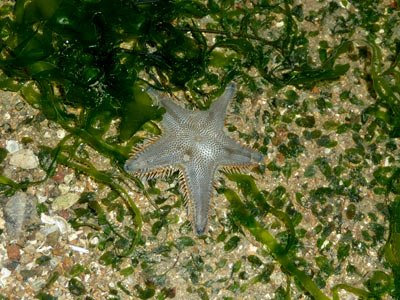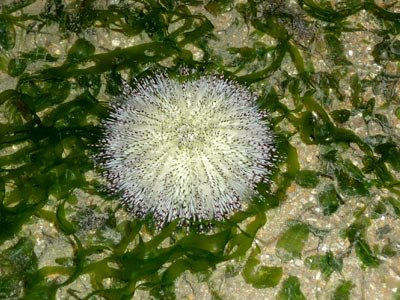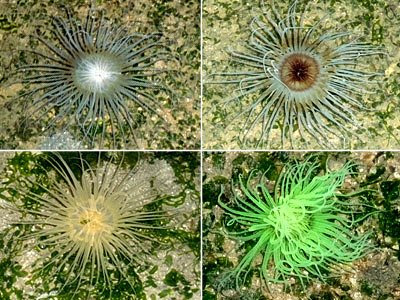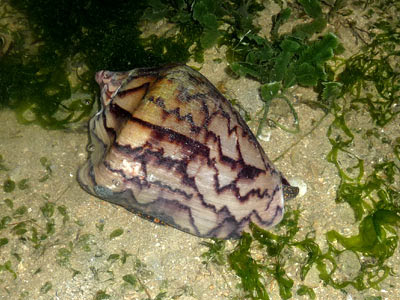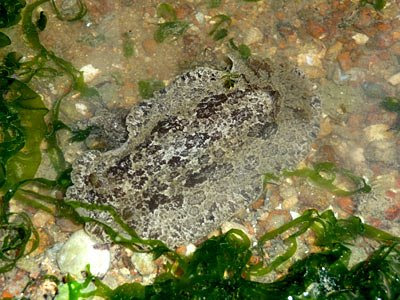We had two wonderful walks at Semakau Landfill over the weekend. I guided a group on Saturday, and was the hunter-seeker on Sunday.
My group's name on Saturday was "Pufferfish", and I had WP as my assistant.

Here's the group crossing the seagrass meadow. The seagrass meadow is a very important habitat for lots of marine life, as there are lots of food and hiding places among the seagrasses.

And here's the group again with the pufferfish look. Too bad they couldn't puff up their belly though. Haha :P

After crossing the seagrass meadow, we soon reached the sea star zone. And indeed, the sea stars were every where. These are the sand-sifting sea stars (
Archaster typicus). They can burrow into the sand to feed on tiny organic particles called detritus, which can be dead organisms broken down into little bits, fragments of organisms or even fecal material.

Our next stop was the gigantic carpet anemone (
Stichodactyla gigantea). This one wasn't very big though, its growth probably restricted by the little tidal pool it's in. This sea anemone has stinging tentacles to sting and capture little animals which got too close to it. The prey will then be transferred to the mouth at the middle.

Another anemone we saw was this Haddon's carpet anemone (
Stichodactylla haddoni).

The noble volutes (
Cymbiola nobilis) at Semakau seem to lay eggs all year round, and we had been seeing many of them doing that on most of our trips for the past one year.

We saw a spiral melongena (
Pugilina cochlidium) laying eggs too. You can see that it blends in very well with the surrounding, and that's because a spiral melongena has lots of tiny hair on its shell that traps sediments, making it looks just like the sand around it.

This little fellow is a blue swimming crab (probably
Thalamita crenata). Its two back legs were paddle-shaped that allowed it to swim. This is a rather aggressive crab. In some countries where they can be found, people do collect them for food, but they are usually not sold in the market probably because they are too small to have much meat compared to the other swimming crab species.

This was a great weekend for nudibranchs, and we saw several different species, including the chromodoris nudibranch (
Chomodoris lineolata) above. Nudibranch means "naked gills", and the latter refers to the little flower-like gills exposed on the back of many nudibranchs.

We saw several glossodoris nudibranchs (
Glossodoris atromarginata) too. Many nudibranchs can release chemicals that make them distasteful or even toxic to predators. This nudibranch belongs to the former, and it can release a whitish chemical to make it distasteful.

The pustulose phyllid nudibranch (
Phyllidiella pustulosa) is a very toxic nudibranch which can release toxins into the surrounding water when it is stressed. It is said that the toxin released by a phyllid nudibranch can kill an entire tank of fish!

We saw a platydoris nudibranch (
Platydoris scabra) again this weekend. All the above nudibranchs feed on sponges.

Can you find the octopus (Order Octopoda) above? Octopuses are masters of camouflage, and they can change their colour to blend into their surrounding. Singapore's octopuses are not very well-studied though, and thus most of the time we are not sure what species they belong to.

At the edge of the reef, we saw the resident fluted giant clam (
Tridacna squamosa). This clam can grow up to 40cm wide, and are over-collected in many countries for food.

And once again, we also found the resident stinging anemone (Family Aliciidae). I've been finding it around the same area for the past one month. Hopefully it'll stay around there for good. This anemone is supposed to give very painful stings.

We saw many pretty corals, but I only remembered to took a photo of this sunflower mushroom coral (
Heliofungia actiniformis). This is a free-living solitary coral, unlike most other corals that live in colonies attached to the substrate.

We also saw many different sea cucumbers, but I only took a photo of this sandfish sea cucumber (
Holothuria scabra). This sea cucumber can burrow into the sand, and like the sand-sifting sea star, it feeds on detritus too.

And of course, the stars of our trip are always the knobbly sea stars (
Protoreaster nodosus).

And here's the traditional group shot with the stars of the day :)

We found a few black long-spined sea urchins (
Diadema setosum) too. The one above was found on Sunday when I was the hunter-seeker. This sea urchin feeds on algae with its mouth that is located on its underside.

On Saturday, we also found a file snake (
Acrochordus granulatus) near the edge of the reef! This is the second time we saw live file snakes at Semakau near the reef edge. There's one time when we saw a dead one. This snake is non-venomous. Somehow, the file snakes on Semakau, at least the ones we've seen, are always covered with algae. Not sure why.

And YES! Our Pufferfish Group also saw a pufferfish (Family Tetraodontidae)! Pufferfishes are able to inflat themselves quickly with water or air, which supposedly could surprise their predator, thus giving them time to escape. Many puffers also contain a powerful neurotoxin, which could be lethal to those who eat them.

We were quite lucky to have found 3 seahorses (
Hippocampus sp.) on Saturday, and 1 on Sunday. And one of the seahorses we found on Saturday was a pregnant male! Male seahorses share the burden of motherhood with the females. The females will lay eggs into a pouch located at the belly of the males, and eventually little seahorses will hatch inside the pouch.

On Sunday, we also found a cute little spotted-tail frogfish (
Lophiocharon trisignatus)! Just look at how well-camouflaged it is!

Also on Sunday, we found this pretty purple climber crab (
Metopograpsus sp.). This crab usually scavenges for dead animals on rocky shores.

Again on Sunday, I also found this huge sawedged spooner (
Etisus utilis). The tip of its claws were spoon-shaped to allow it to scape algae off rocks to eat.

On Saturday, we also had a CNA crew following my group, and they interviewed some of the participants.
I'm certainly looking forward to see what aspects of this wonderful island that they have captured on film :)



















